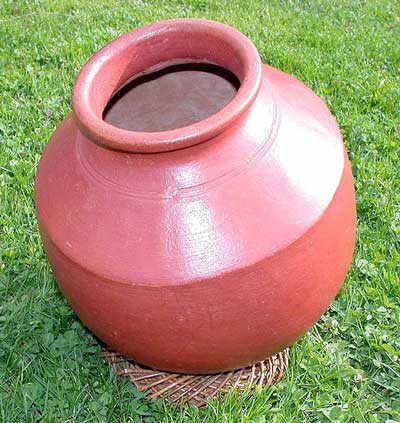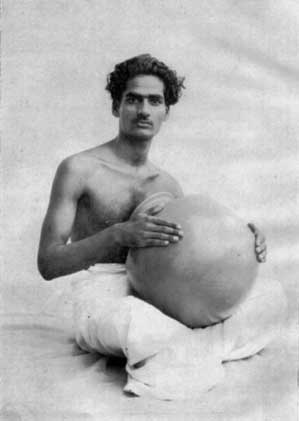
Ghatam is nothing more than a large clay pot. It is very commonly played in South Indian classical performances. There are two actions of resonance. The primary one is the ringing of the pot caused by striking. A very low resonance is also produced by the cavity.

The primary mode of playing is based upon the vibration of the pot. From a physical standpoint, it is complicated as the resonance characteristics of all all ideophones tend to be. Idiophones such cymbals, castanets, and similar instruments, are some of the oldest musical instruments on earth.
However, the ghatam has another mode of playing where the resonance does not come from the pot but from the cavity. This is referred to as a Helmholtz resonator. The most well known example of a Helmholtz resonator is the ocarina, but it also shows up in some of the bass pipes of a pipe organ. The pitch of this may be varied by partially opening or closing the mouth of the pot with the stomach.
Selected Video
Other Sites of Interest
Bharatiya Sangeet Vadya (Review)
Catalogue of Indian Musical Instruments
Fractal dimension analysis of audio signals for Indian musical instrument recognition
Natural synthesis of North Indian musical instruments
Recognition of Indian Musical Instruments with Multi-Classifier Fusion
The Tagore collection of Indian musical instruments
Improvement of Audio Feature Extraction Techniques in Traditional Indian Musical Instrument
East Indians musical instruments
Modeling Carnatic Rhythm Generation: A Data Driven Approach Based on Rhythmic Analysis
Rhythm and Timbre Analysis for Carnatic Music Processing
Impact of Carnatic Music Training on the Mathematical Ability of Children
CAMEL: Carnatic Percussion Music Generation using N-Gram Models
Hierarchical Classification of Carnatic Music Forms
